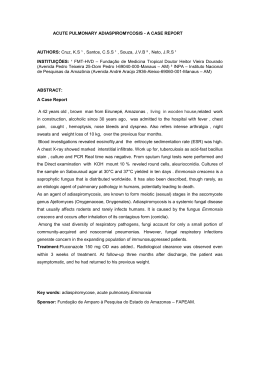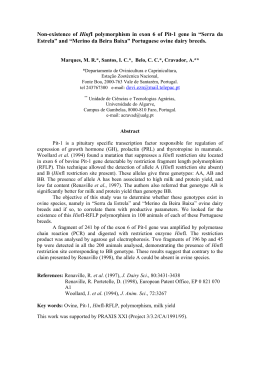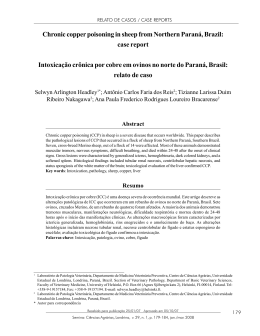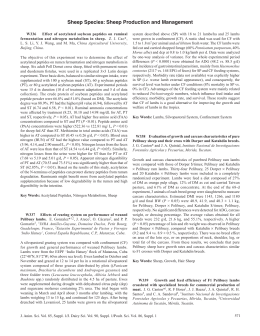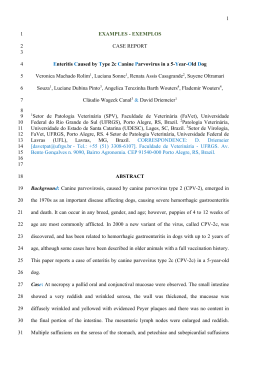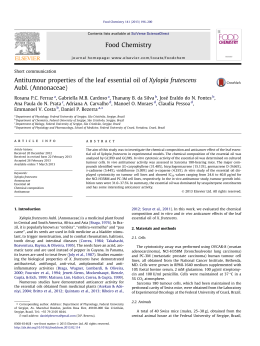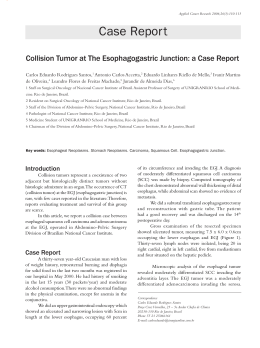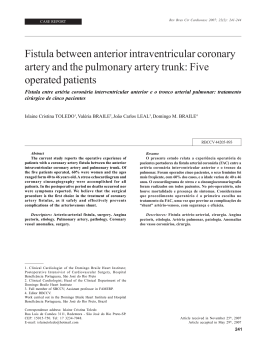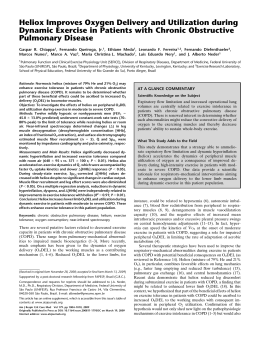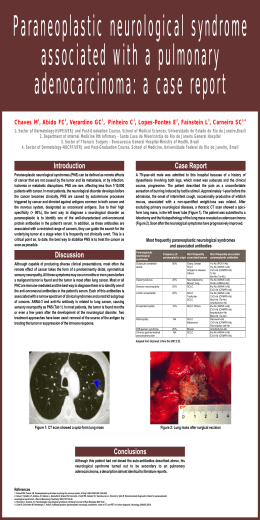NB: Ve rsion a dopted by the Worl d A ssembly of De legates of the OIE in May 2014 CHAPTER 2.7.10. OVINE PULMONARY ADENOCARCINOMA (adenomatosis) SUMMARY Ovine pulmonary adenocarcinoma (OPA), also known as ovine pulmonary adenomatosis and jaagsiekte, is a contagious tumour of sheep and, rarely, of goats. It is a progressive respiratory disease, principally affecting adult animals. The disease occurs in many regions of the world. A betaretrovirus (jaagsiekte sheep retrovirus: JSRV), distinct from the non-oncogenic ovine lentiviruses, has been shown to cause the disease. Identification of the agent: JSRV cannot yet be propagated in vitro, therefore routine diagnostic methods, such as virus isolation, are not available for diagnosis. Diagnosis relies, at present, on clinical history and examination, as well as on the findings at necropsy and by histopathology and immunohistochemistry. Viral DNA or RNA can be detected in tumour, draining lymph nodes, and peripheral blood mononuclear cells by polymerase chain reaction. Lambs become persistently infected by JSRV at an early age, and, in an OPA-affected flock, most sheep are infected. Serological tests: Antibodies to the retrovirus have not been detected in infected sheep; therefore, serological tests are not available for diagnosis. Requirements for vaccines: There are no vaccines available. A. INTRODUCTION Ovine pulmonary adenocarcinoma (OPA), also known as ovine pulmonary adenomatosis, jaagsiekte (Afrikaans = driving sickness) and ovine pulmonary carcinoma (OPC), is a contagious lung tumour of sheep and, more rarely, of goats. It is the most common pulmonary tumour of sheep and occurs in many countries around the world. It is absent from Australia and New Zealand and has been eradicated from Iceland. A number of different viruses have been linked aetiologically to OPA, including a herpesvirus and lentiviruses, which have been propagated from tumour tissue. However, the former does not have an aetiological role in OPA and the latter exhibit characteristics of non-oncogenic lentiviruses. It has been demonstrated clearly that OPA is caused by a betaretrovirus that cannot yet be cultured in vitro, but the virus has been cloned and sequenced. The term jaagsiekte sheep retrovirus (JSRV) is used in referring to this virus. B. DIAGNOSTIC TECHNIQUES At present, diagnosis of OPA relies on clinical and pathological investigations, although polymerase chain reaction (PCR) offers hope for ante-mortem diagnosis of OPA as a flock test. In flocks in which the disease is suspected, its presence must be confirmed, at least once, by histopathological examination of affected lung tissue. For such an examination, it is imperative to take specimens from several affected sites and, if possible, from more than one animal. This is because secondary bacterial pneumonia, which might be the immediate cause of death, often masks the lesions (both macroscopic and microscopic) of the primary disease. In the absence of specific serological tests that can be used for the diagnosis of OPA in live animals, disease control relies on strict biosecurity to prevent the introduction of the disease to OPA-free countries and flocks; where the disease already exists, control relies on regular flock inspections and prompt culling of suspected cases and, in the case of ewes, their offspring. However, clinical examination has been shown to be unreliable for detection of early OPA cases (Cousens et al., 2008). There is no known risk of human infection with JSRV. Biocontainment measures should be determined by risk analysis as described in Chapter 1.1.3a Standard for managing biorisk in the veterinary laboratory and animal facilities. OIE Terrestrial Manual 2014 1 Chapter 2.7.10. — Ovine pulmonary adenomatosis (adenocarcinoma) Table 1. Test methods available for the diagnosis of ovine pulmonary adenocarcinoma and their purpose Purpose Method Population freedom from infection Individual animal freedom from infection prior to movement Confirmation of eradication policies Confirmation of clinical cases Prevalence of infection – surveillance Immune status in individual animals or populations post-vaccination Agent identification1 PCR + + + ++ ++ n/a Histopathology – + + +++ + n/a Key: +++ = recommended method; ++ = suitable method; + = may be used in some situations, but cost, reliability, or other factors severely limits its application; – = not appropriate for this purpose; n/a = not applicable. Although not all of the tests listed as category +++ or ++ have undergone formal validation, their routine nature and the fact that they have been used widely without dubious results, makes them acceptable. *This includes identification by both polymerase chain reaction (PCR) in either blood or tumour samples. 1. Identification of the agent Although ovine herpesvirus 1 (OvHV-1) had been isolated exclusively from OPA tumours, epidemiological studies and experimental infections provide no evidence for a role in the aetiology of OPA. Ovine herpesvirus 2 (OvHV-2) is the sheep-associated malignant catarrhal fever herpesvirus and has never been linked to OPA. The association of retroviruses with OPA has been recognised for several years. Ovine lentiviruses have been isolated on a number of occasions, but these viruses have no aetiological role in OPA. JSRV has been designated as a betaretrovirus because of its genetic organisation and its structural proteins. Although the ovine genome contains approximately 20 copies of endogenous betaretroviruses that are highly related to JSRV (Spencer & Palmarini, 2012), JSRV is clearly exogenous and associated exclusively with OPA (Palmarini et al., 1996). JSRV is detected constantly in the lung fluid, tumour, peripheral blood mononuclear cells, and lymphoid tissues of sheep affected by OPA or unaffected in-contact flockmates, and never in sheep from unaffected flocks with no history of the tumour. Full-length proviral clones of JSRV have been obtained from OPA tumour DNA and cells. JSRV virus particles, prepared from these clones by transient transfection of a cell line, were used for intratracheal inoculation of neonatal lambs. OPA tumour was induced in lambs, thus demonstrating that JSRV is the causal agent of OPA (DeMartini et al., 2001; Palmarini et al., 1999). Although the endogenous betaretroviruses that are highly related to JSRV are not involved in the aetiology of OPA, their expression in the uteroplacental tissues appears to be beneficial (Dunlap et al., 2006) and expression in the fetus may, by induction of tolerance, account for the apparent lack of immune response of mature animals to exogenous JSRV (Palmarini et al., 2004). There are no permissive cell culture systems for propagation of JSRV. Some cell cultures prepared from the tumours occurring in young lambs can support virus replication for a short period (Jassim, 1988; Sharp et al., 1985). 1.1. Nucleic acid recognition methods Single step and hemi-nested JSRV-specific PCRs have been developed, based on primers derived from the U3 region of the JSRV LTR (Table 2) (Palmarini et al., 1997). These can detect JSRV in several tissues, including peripheral blood mononuclear cells of unaffected in-contact sheep from flocks with OPA, as well as experimentally infected lambs (De las Heras et al., 2005; Gonzalez et al., 2001; Holland et al., 1999; Lewis et al., 2011) and in bronchoalveolar lavage samples from unaffected in-contact sheep (Voigt et al., 2007). These PCRs have a high diagnostic specificity but a low diagnostic sensitivity when applied to individual animals, due to low concentrations of target DNA in the blood of clinically healthy animals (De las Heras et al., 2005; Lewis et al., 2011). Longitudinal studies in OPA-affected flocks have shown that lambs become infected at a very early age. A high proportion of animals in these flocks are infected, yet only a minority develops OPA (Caporale et al., 2005; Salvatori, 2005). JSRV has been found in colostrum and milk obtained from sheep in OPA-affected flocks and JSRV can be detected within a few months in the blood of lambs fed artificially with colostrum and milk (Grego et al., 2008). 1 2 A combination of agent identification methods applied on the same clinical sample is recommended. OIE Terrestrial Manual 2014 Chapter 2.7.10. — Ovine pulmonary adenomatosis (adenocarcinoma) Table 2. Primers used in JSRV-specific PCRs Single step PCR Primer Sequence (5’3’) P1 TGG-GAG-CTC-TTT-GGC-AAA-AGC-C Plll CAC-CGG-ATT-TTT-ACA-CAA-TCA-CCG-G P1 TGG-GAG-CTC-TTT-GGC-AAA-AGC-C PVl TGA-TAT-TTC-TGT-GAA-GCA-GTG-CC Hemi-nested PCR (uses product from single-step PCR) 2. Clinical signs and pathology 2.1. Clinical signs There is no reliable laboratory method for the ante-mortem diagnosis of OPA in individual animals, therefore flock history, clinical signs and post-mortem lesions are the primary method for the diagnosis of the disease. As OPA has a long incubation period, clinical disease is encountered most commonly in sheep over 2 years of age, with a peak occurrence at the age of 3–4 years. In exceptional cases, the disease occurs in animals as young as 2–3 months of age. The cardinal signs are those of a progressive respiratory embarrassment, particularly after exercise; the severity of the signs reflects the extent of tumour development in the lungs. Accumulation of fluid within the respiratory tract is a prominent feature of OPA, giving rise to moist rales that are readily detected by auscultation. Raising the hindquarters and lowering the head of affected sheep may cause frothy mucoid fluid to run from the nostrils. Coughing and inappetance are not common but, once clinical signs are evident, weight loss is progressive and the disease is terminal within weeks or months. Death is often precipitated by a superimposed bacterial pneumonia, particularly that due to Mannheimia (formerly Pasteurella) haemolytica. In clinically affected animals, a peripheral lymphopenia characterised by a reduction in CD4+ T lymphocytes and a corresponding neutrophilia may assist clinical diagnosis, but the changes are not pathognomonic and are not detected during early experimental infection (Summers et al., 2002). In some countries, another form of OPA (atypical OPA) occurs, which generally presents as an incidental finding at necropsy or the abattoir (De las Heras et al., 2003). 2.2. Necropsy OPA lesions are in most cases confined to the lungs, although intra- and extrathoracic metastasis to lymph nodes and other tissues can occur. In typical cases, affected lungs are considerably enlarged and heavier than normal due to extensive nodular and coalescing firm grey lesions affecting much of the pulmonary tissue. Usually lesions are present in both lungs, although the extent on either side does vary. Tumours are solid, grey or light purple with a shiny translucent sheen and often separated from the adjacent normal lung by a narrow emphysematous zone. The presence of frothy white fluid in the respiratory passages is a prominent feature and is obvious even in lesions as small as a few millimetres. In advanced cases, this fluid flows out of the trachea when it is cut or pendant. Samples should be taken at necropsy for histopathology, immunohistochemistry or PCR for JSRV. Pleurisy may be evident over the surface of the tumour and often abscesses are present in the adenomatous tissue. In atypical OPA, tumours comprise solitary or aggregated hard white nodules that have a dry cut surface and show clear demarcation from surrounding tissues. The presence of excess fluid is not a prominent feature. Adult sheep, which on post-mortem examination appear to have died from acute pasteurellosis, should have their lungs examined carefully, as lesions of OPA may be masked by coexisting bronchopneumonia, verminous pneumonia, chronic progressive pneumonia (maedi-visna) or combinations of these. Samples should be taken at necropsy for histopathology. OIE Terrestrial Manual 2014 3 Chapter 2.7.10. — Ovine pulmonary adenomatosis (adenocarcinoma) 2.3. Histopathology Histologically, the lesions are characterised by proliferation of mainly type II pneumocytes, a secretory epithelial cell in the pulmonary alveoli. Nonciliated (Clara) and epithelial cells of the terminal bronchioli may be involved. The cuboidal or columnar tumour cells replace the normal thin alveolar cells and sometimes form papilliform growths that project into the alveoli. Intrabronchiolar proliferation may be present. In advanced cases, extensive fibrosis may develop and, occasionally, nodules of loose connective tissue in a mucopolysaccharide substance may be present. A prominent feature is the accumulation of large numbers of alveolar macrophages in the alveoli adjacent to the neoplastic lesions (Summers et al., 2005). Where maedi-visna is concurrent, perivascular, peribronchiolar and interstitial lymphoid infilrates may be prominent. The histological appearance of atypical OPA is essentially the same as classical OPA, but with an exaggerated inflammatory response (mostly lymphocytes and plasma cells) and fibrosis (De las Heras et al., 2003). For more detailed accounts of the clinical, post-mortem and histopathological aspects of OPA, the reader is referred elsewhere (De las Heras et al., 2003; Sharp & DeMartini, 2003; Summers et al., 2012). There appears to be a synergistic interaction between OPA and maedi-visna. Lateral transmission of maedi-visna virus appears to be enhanced in sheep affected by OPA (Dawson et al., 1985; Gonzalez et al., 1993). 3. Serological tests At present, there are no laboratory tests to support a clinical diagnosis of OPA in the live animal. JSRV has been associated exclusively with both typical and atypical forms of OPA, but antibodies to this virus have not been detected in the sera of affected sheep, even with highly sensitive assays such as immunoblotting or enzymelinked immunosorbent assay (Ortin et al., 1997; Summers et al., 2002). C. REQUIREMENTS FOR VACCINES There are no vaccines available at the present time. REFERENCES CAPORALE M., CENTORAME P., GIOVANNINI A., SACCHINI F., DI VENTURA M., DE LAS HERAS M. & PALMARINI M. (2005). Infection of lung epithelial cells and induction of pulmonary adenocarcinoma is not the most common outcome of naturally occurring JSRV infection during the commercial lifespan of sheep. Virology, 338, 144–153. COUSENS C., GRAHAM M., SALES J. & DAGLEISH M.P. (2008). Evaluation of the efficacy of clinical diagnosis of ovine pulmonary adenocarcinoma. Vet. Rec., 162, 88–90. DAWSON M., VENABLES C. & JENKINS C.E. (1985). Experimental infection of a natural case of sheep pulmonary adenomatosis with maedi-visna virus. Vet. Rec. 116, 588–589. DE LAS HERAS M., GONZALEZ L.G. & SHARP J.M. (2003). Pathology of ovine pulmonary adenocarcinoma. Curr. Top. Microbiol. Immunol., 275, 25–54 DE LAS HERAS M., ORTÍN A., SALVATORI D., PÉREZ DE VILLAREAL M., COUSENS C., FERRER L.M., GARCÍA DE JALÓN J.A., GONZALEZ L. & SHARP J.M. (2005). A PCR technique for the detection of Jaagsiekte retrovirus in the blood suitable for the screening of virus infection in sheep flocks. Res. Vet. Sci., 79, 259–264. DEMARTINI J.C., BISHOP J.V., ALLEN T.E., JASSIM F.A., SHARP J.M., DE LAS HERAS M., VOELKER D.R. & CARLSON J.O. (2001). Jaagsiekte sheep retrovirus proviral clone JSRVJS7, derived from the JS7 lung tumor cell line, induces ovine pulmonary carcinoma and is integrated into the surfactant protein A gene. J. Virol., 75, 4239–4246. 4 OIE Terrestrial Manual 2014 Chapter 2.7.10. — Ovine pulmonary adenomatosis (adenocarcinoma) DUNLAP K.A., PALMARINI M. & SPENCER T.E. (2006). Ovine endogenous betaretroviruses (enJSRVs) and placental morphogenesis. Placenta, 27, Suppl. A:S135–S140. GONZALEZ L., GARCIA-GOTI M., COUSENS C., DEWAR P., CORTABARRIA N., EXTRAMIANA B., ORTIN A., DE LAS HERAS M. & SHARP J.M. (2001). Jaagsiekte sheep retrovirus can be detected in the peripheral blood during the preclinical period of sheep pulmonary adenomatosis. J. Gen. Virol., 82, 1355–1358. GONZALEZ L., JUSTE R.A., CUERVO L.A., IDIGORAS I. & SAEZ DE OCARIZ C. (1993). Pathological and epidemiological aspects of the coexistence of maedi-visna and sheep pulmonary adenomatosis. Res. Vet. Sci., 54, 140–146. GREGO E., DE MENEGHI D., ALVAREZ V., BENITO A.A., MINGUIJON E., ORTIN A., MATTONI M., MORENO B., PÉREZ DE VILLARREAL M., ALBERTI A., CAPUCCHIO M.T., CAPORALE M., JUSTE R., ROSATI S. & DE LAS HERAS M. (2008). Colostrum and milk can transmit jaagsiekte retrovirus to lambs. Vet. Microbiol., 130 (3–4), 247–257. HOLLAND M.J., PALMARINI M., GARCIA-GOTI M., GONZALEZ L., DE LAS HERAS M. & SHARP J.M. (1999). Jaagsiekte retrovirus establishes a pantropic infection of lymphoid cells of sheep with naturally and experimentally acquired pulmonary adenomatosis. J. Virol., 73, 4004–4008. JASSIM F.A. (1988). Identification and characterisation of transformed cells in jaagsiekte, a contagious lung tumour of sheep. PhD thesis. University of Edinburgh, UK. LEWIS F.I., BRULISAUER F., COUSENS C., MCKENDRICK I.J. & GUNN G. (2011). Diagnostic accuracy of PCR for Jaagsiekte sheep retrovirus using field data from 125 Scottish sheep flocks. Vet. J., 187, 104–108. ORTIN A., MINGUIJON E., DEWAR P., GARCIA M., FERRER L.M., PALMARINI M., GONZALEZ L., SHARP J.M. & DE LAS HERAS M. (1997). Lack of a specific immune response against a recombinant capsid protein of Jaagsiekte sheep retrovirus in sheep and goats naturally affected by enzootic nasal tumour or sheep pulmonary adenomatosis. Vet. Immunol. Immunopathol., 61, 239–237. PALMARINI M., COUSENS C., DALZIEL R.G., BAI J., STEDMAN K, DEMARTINI J.C. & SHARP J.M. (1996). The exogenous form of Jaagsiekte retrovirus (JSRV) is specifically associated with a contagious lung cancer of sheep. J. Virol., 70, 1618–1623. PALMARINI M., HOLLAND M., COUSENS C., DALZIEL R.G. & SHARP J.M. (1997). Jaagsiekte sheep retrovirus establishes a disseminated infection of lymphoid tissues of sheep affected by pulmonary adenomatosis. J. Gen. Virol., 77, 2991–2998. PALMARININ M., MURA M. & SPENCER T. (2004). Endogenous betaretroviruses of sheep: teaching new lessons in retroviral interference and adaptation. J. Gen. Virol., 85, 1–13. PALMARINI M., SHARP J.M., DE LAS HERAS M. & FAN H.Y. (1999). Jaagsiekte sheep retrovirus is necessary and sufficient to induce a contagious lung cancer in sheep. J. Virol., 73, 6964–6972. SALVATORI D. (2005). Studies on the pathogenesis and epidemiology of ovine pulmonary adenomatosis (OPA). PhD thesis, University of Edinburgh, Scotland, UK. SALVATORI D., COUSENS C., DEWAR P., ORTIN A., GONZALEZ L., DE LAS HERAS M., DALZIEL R.G. & SHARP J.M. (2004). Effect of age at inoculation on the development of ovine pulmonary adenocarcinoma. J. Gen. Virol., 85, 3319– 3324. SHARP J.M. & DEMARTINI J.C. (2003). Natural history of JSRV in sheep. Curr. Top. Microbiol. Immunol., 275, 55– 79. SHARP J.M., HERRING A.J., ANGUS K.W., SCOTT F.M.M. & JASSIM F.A. (1985). Isolation and in vitro propagation of a retrovirus from sheep pulmonary adenomatosis. In: Slow Virus Diseases in Sheep, Goats and Cattle. Sharp J.M. & Hoff-Jorgensen R., eds. CEC Report EUR 8076 EN, Luxembourg, 345–348. SPENCER T.E. & PALMARINI M. (2012). Endogenous retroviruses of sheep: a model system for understanding physiological adaptation to an evolving ruminant genome. J. Reprod. Dev., 58, 33–37. SUMMERS C., BENITO A., ORTIN A., GARCIA DE JALON J., GONZALEZ L., NORVAL M., SHARP J.M. & DE LAS HERAS M. (2012). The distribution of immune cells in the lungs of classical and atypical ovine pulmonary adenocarcinoma. Vet. Immunol. Immunopathol., 146, 1–7. OIE Terrestrial Manual 2014 5 Chapter 2.7.10. — Ovine pulmonary adenomatosis (adenocarcinoma) SUMMERS C., NEILL W., DEWAR P., GONZALEZ L., VAN DER MOLEN R., NORVAL M. & SHARP J.M. (2002). Systemic immune responses following infection with jaagsiekte sheep retrovirus and in the terminal stages of ovine pulmonary adenocarcinoma. J. Gen. Virol., 83, 1753–1757. SUMMERS C., NORVAL M., DE LAS HERAS M., GONZALEZ L., SHARP J.M. & WOODS G.M. (2005). An influx of macrophages is the predominant local immune response in ovine pulmonary adenocarcinoma. Vet. Immunol. Immunopathol., 106, 285–294. VOIGT K., BRÜGMANN M., HUBER K., DEWAR P., COUSENS C., HALL M., SHARP J.M. & GANTER M. (2007). PCR examination of bronchoalveolar lavage samples is a useful tool in pre-clinical diagnosis of ovine pulmonary adenocarcinoma (Jaagsiekte). Res. Vet. Sci., 83 (3), 419–427. * * * 6 OIE Terrestrial Manual 2014
Download
